Underland: A Deep Time Journey
Air Date: Week of September 6, 2019
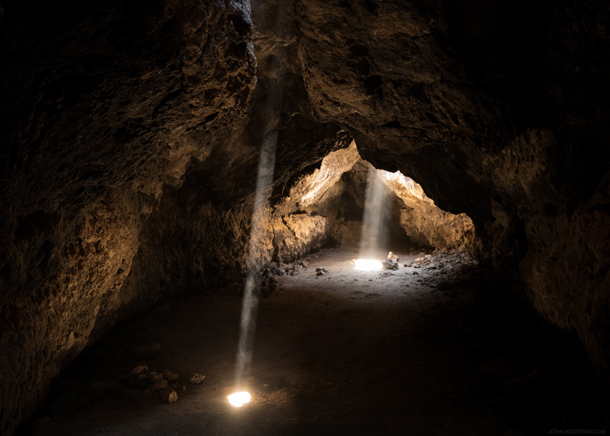
“Darkness is an illumination down there, as well.” – Robert Macfarlane (Photo: Joshua Sortino on Unsplash)
Many nature writers turn our eyes skyward, towards majestic mountains, open valleys, and wild rivers. But there’s a whole other world beneath our feet, in the dark and hidden places below the Earth’s surface—a place that the British author Robert Macfarlane calls the "Underland.” For nearly a decade, Macfarlane has been venturing into ice caves, exploring underwater rivers, and crawling through catacombs to discover this underworld, and he captures these travels in his latest book, Underland: A Deep Time Journey. Robert Macfarlane tells Living on Earth's Jenni Doering what drives him to explore the “deep time” that runs down below.
Transcript
Many nature writers look skyward, towards majestic mountains, open valleys, and wild rivers. But there’s a whole other world beneath our feet, in the dark and hidden places below the Earth’s surface. This is the place that the British author Robert Macfarlane calls the "Underland.” For nearly a decade, he has been venturing into ice caves, exploring underwater rivers, and crawling through catacombs to discover this hidden world that can be both beautiful and macabre.
His latest book, Underland: A Deep Time Journey, documents these travels and explores the human relationship with the "deep time" of down below. Living on Earth's Jenni Doering spoke with Robert Macfarlane.
DOERING: So, let's start off with a big question. What is the underland?
MACFARLANE: Yes, that is a very good question. And I guess there's a 500-page answer to that. But the short version of that would be all that, all that lies beneath us, and particularly, that which lies below the surface of the land. And it's a place that we have shunned and been frightened by, but also been drawn to for as long as we have been anatomically modern humans and indeed longer than that. So, I wrote a book about mountains a very long time ago, which tried to work out why people go high; this, this is an attempt to answer the question of why people go low, and what they find when they do.
DOERING: You say that we tend to shun the underland. Why is that?
MACFARLANE: It's dark, it's dirty, it's hard to get anywhere. It's associated with death, with mortality, with confinement, exploitative labor practices, incarceration. It has a pretty bad rap, but it is also teeming with wonder and secrets. And those are its two sides. Darkness is an illumination down there as well.
DOERING: It's amazing what's just underneath the surface.
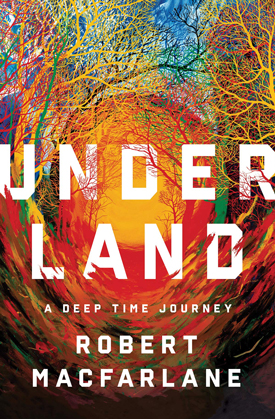
Underland: A Deep Time Journey explores the little-known world beneath our feet. (Photo: courtesy of W. W. Norton)
MACFARLANE: Yeah, that's it. I, I say really early on in the book, look up and you can see literally trillions of miles on a clear night. You look down, and your sight stops at the ground. And yeah, and that's why we know so little, because we are so kind of optically charged in our knowledge.
DOERING: I mean, it seems to hold this incredible power for you as you’re journeying through, as you're going through the catacombs in France and this underground river running through Italy.
MACFARLANE: Yeah.
DOERING: I mean, reading your book, it almost felt like you were traveling to Hades and back.
MACFARLANE: [LAUGHS] Well, someone just introduced me to this great musical of yours, Hadestown, which just cleaned up at the Tonys. So, I have some of the songs from Hadestown going through my mind, but I think there is a great playlist to be made from the underworld songs, the jams going underground... Anyway, so it goes. But yeah, it's it's a zone of myth. Hades is one of those; classical myth is filled with what they call the katabasis, that journey down into the underworld often to retrieve something of value, a loved one; or to consult with somebody, the dead about the future. And I guess that that it did come to have that, that pull for me. But I was always guided, okay. The book is filled with these mycologists and glaciologists and all people who have intense relationships with what lies beneath imaginative, or, or otherwise. And they cast the light, they held the light for me.
DOERING: The subtitle of your book is " A Deep Time Journey". Can you explain what deep time means to you?
MACFARLANE: Yeah, deep time is, is a phrase actually, that John McPhee, that great nonfiction writer comes up with, New Yorker writer. But it's an old concept, as old as geology. But basically, it is Earth history in its full units of age and ancientness -- the epoch, the Eon, the era -- not the minute, the second, the week, the year. Deep time crushes our units to a wafer, really, to an irrelevance, it seems. But so deep time means Earth historical time. But I think what's striking to me about the Anthropocene, arguably, is that we have accelerated, we have shallowed, deep time; or we've scrambled deep time and suddenly all these things -- we burn Carboniferous-era fossil fuels to melt Pleistocene-era ice to determine Anthropocene future climates. And suddenly, deep time is no longer sequential and orderly, if it ever was, and it's, it's muddled. And that's an unsettlement for us.
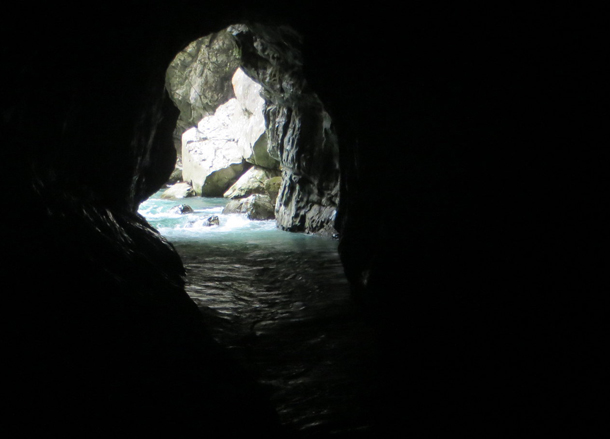
Entrance to an underground river in Slovenia, part of the “starless river” system Macfarlane describes in his book. (Photo: Martijn Booister, Flickr CC BY-NC 2.0)
DOERING: How did you choose the places that you wanted to visit for this book?
MACFARLANE: They chose themselves. I -- this may be a post-op rationalization, but it did feel afterwards as though I was uncovering a kind of buried structure that already existed. I knew I wanted to write about deep time, I knew I couldn't only do that in my own body and my own voice, because I am a shallow time human being. [LAUGHS] And so there are parts of the book that are told, not by me, but just they move around within the deep time history of the underworld and around the geography of the globe, as well as in Gaza, or they're in the Cretaceous, or they're in America where nuclear waste storage facilities are being constructed in Yucca Mountain and so forth. But the main parts of the book occur in Britain, then in central and Eastern Europe, and then in the north, and the Arctic. And that that's just the way it fell out.
DOERING: There's a lot of nature in this book, of course, but there's also man-made structures, like I'm thinking of the catacombs under Paris, France. And so, you traveled down there. What was it like to be down there in the catacombs of Paris, France?
MACFARLANE: The first thing to say is I was down there for two and a half days, which is the longest I've ever gone -- which isn't very long, but is longer, I suspect than most people have gone without seeing the sky or the sun or the surface or anything. And I went down with an amazing person called Lina, who was generous and bold and brave and rather different underground than she was above ground. She was gentle in both places, but she was quite quiet above ground, but had to be quite decisive. And she had this amazing navigational ability down there. She really didn’t consult a map. She’s been down there lots and lots, and she could just map it in her brain. It was like she had GPS for the catacombs. [LAUGHS] So, we yeah, we spent time down there sleeping in the dark, and you do lose track of time. And you also realize you're in limestone, which is, which is a rock made of, of death, basically of accumulated bodies of marine microorganisms, and also filled with the dead of Paris.
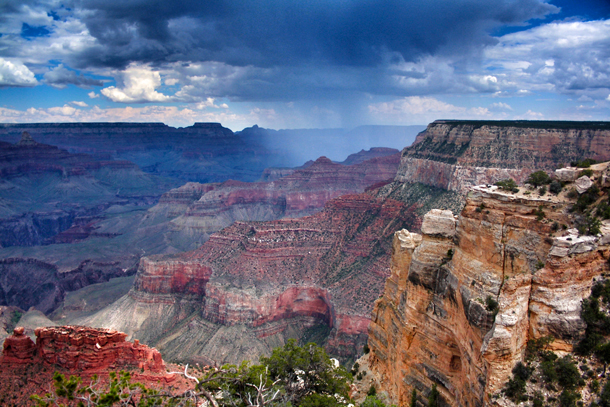
Deep time: the Grand Canyon reveals rock layers laid down over hundreds of millions of years. (Photo: morais on Unsplash)
DOERING: The Underland seems like such a place that evokes extremes of emotion -- wonder, as well as fear. How did these emotions manifest for you, in your explorations of the Underland?
MACFARLANE: That's a great question. And I was a conduit in a way; I mean, we have mined from it meaning as well as resource. So, I'm just one of, you know, a billion billion meaning makers. But there was one point in Norway where I, I just wept. When I, when I got into this deep sea cave, where cave art had been made about two and a half thousand years previously by really marginal, what we would call Bronze Age, and together is Peri-Arctic, peripatetic people. And then they painted these figures, the red dancers, out of iron oxide on the cave wall, deep inside this Granite Mountain, in a brutally wild place. So, and when I finally got there, after a really hard winter journey on my own, I was overcome.
DOERING: You worked for nearly a decade on writing this book. How did your relationship with the underland evolve over time?
MACFARLANE: Well, yeah, you're right that the idea first came in about 2010. And that was the year of the Deepwater Horizon blow-out, of the Icelandic volcano eruption, of the Chilean miners trapped underground. It was a real underworld year. I really started working in 2012. I think I -- a couple of things. One is I began to understand deep time as running forwards as well as backwards. And the second was just the age of the time we have spent being drawn into darkness. I wrote this book about mountains and, and why we're drawn to mountain tops. But that is so young, that is just punk-ishly young, that cultural impulse [LAUGHS], not even 300 years old. But we have been going into the darkness as a species, leaving those prints on the cave wall, those handprints on the cave wall that we've all seen the images of, for tens and tens and tens of thousands of years. So, something is at work there. And that is inexhaustibly fascinating to me.
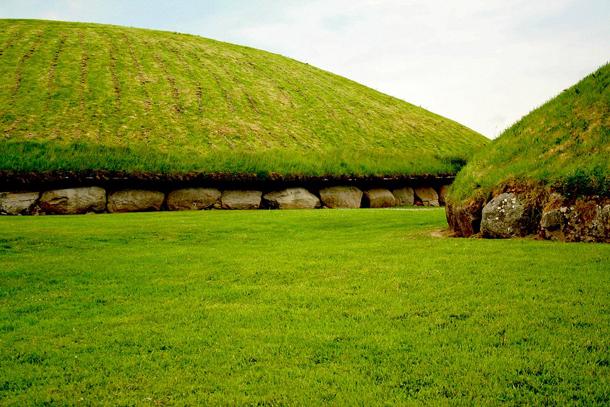
Neolithic burial mounds at Knowth, Ireland. In Underland Robert Macfarlane explores the ancient human practice of burying our dead. (Photo: 1sock, Flickr CC BY-NC-ND 2.0)
DOERING: As you've alluded to, humans have used the underland for -- I guess, as long as we've been around, almost? What are the different ways that we've found it useful to us?
MACFARLANE: Well, I say early on, but it took me a long time to work this out, that I think I call the three great tasks of the Underland. And they are to shelter, to yield and to dispose. So, to shelter is -- you know, where we put the bodies of our loved ones in a way to keep them safe, so we can go back and meet them again. It's where the Germans are putting all of their state documents and microfiche, or at the Svalbard Seed Vault, we're putting all of the, as much of seed biodiversity as we can in storage. So, that's this sheltering. And then yield -- obviously, we're a mining species, we're a burrowing species, we've drilled 50 million kilometers of oil borehole alone. We've mined so much wealth out of the earth. So, we go, we go to take knowledge, we go to take matter. And then dispose is where we put the stuff we don't want. Our nuclear waste, our sewage. The Cloaca Maxima in Rome was the -- yeah, the great, basically the great sewer at the heart of Rome, that Rome would just chuck all its stuff into. So, the underworld is our sump, is our shelter and is a treasure chest.
DOERING: In your book, you're thinking about the past, you're also thinking about the future. And you asked this really interesting, unique question: are we being good ancestors? What do you think the answer is to that?
MACFARLANE: No, no, no, we're not. And I think we're being asked to think more and harder about ancestry now in but in the sense, not of backwards in time, but forwards in time. And for me, that is, that is the deep time of this book, is actually not just the stuff which falls away behind us for billions of years, but what we're leaving.
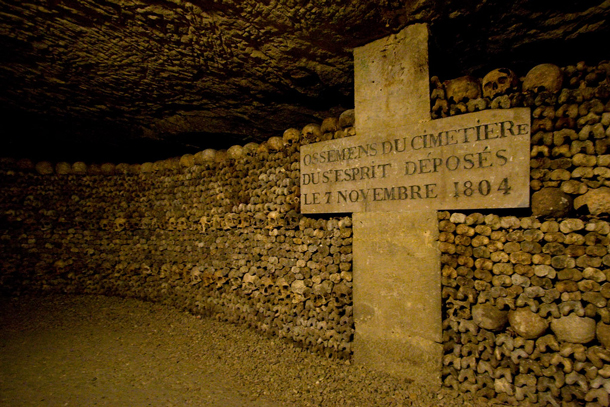
Robert Macfarlane and two companions spent days wandering the labyrinthine catacombs underneath Paris, France, where ossuaries such as this one hold the remains of more than six million people. (Photo: Dave Shea, Flickr CC BY-NC-ND 2.0)
DOERING: Do you think there's anything we can do to do a better job of leaving a good future for those who come after us?
MACFARLANE: Yeah, I do. There are countless things we can do. I mean, if we think just in terms of Anthropocene future fossils, like what, in a very literal way, what will be our future fossils? It doesn't look great. We're going to leave lots of sheep, cow and pig bones behind. We're going to leave an absence of surface soil; we're going to leave an absence of biodiversity. We're going to leave a massive spike of nitrogen. We're going to leave radionuclides from our testings, we're going to leave fly ash and lead. It's a pretty good ugly record, particularly those extinctions and the habitat loss; that might be our script. So, I would love us to exit the Anthropocene and turn up in a -cene called something like the symbioscene, or the mutualcene, or the sustainability-cene, but it's -- we've got to, we've got to actually, for so many reasons.
DOERING: Robert, is there a passage that you'd like to read for us from your book?
MACFARLANE: Well, thinking about what we've been talking about, about the Anthropocene about things surfacing about time running fast, as well as slow, I'll read you a bit about a section from an extraordinary event, a calving event at a glacier, way up the remote east coast of Greenland in 2016. And I mention the year because that was a year of intense melt. Nuuk, the capital of Greenland, was at 22 degrees C, which is not what Greenland's capital should be feeling in that the ice cap was melting, the glaciers were running and calving fast, and we saw this extraordinary event.
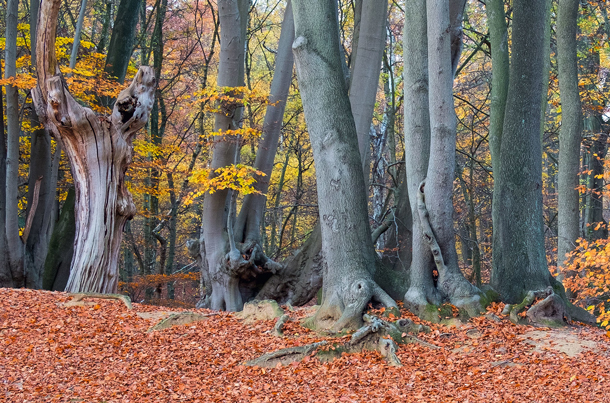
In forests such as Epping Forest outside London, trees are linked via roots and fungi in an intricate underground network known as the “wood wide web.” (Photo: M W Pinsent, Flickr CC BY-NC-ND 2.0)
"'There!' shouts Bill, but we're all already looking there, where the first block fell, for it seems that a white freight train is driving fast out of the calving face of the glacier, thundering laterally through space before toppling down towards the water. And then the white train is suddenly somehow pulling white wagons behind it from within the glacier, like an impossible magician's trick. And then the white wagons are followed by a cathedral, a blue cathedral of ice complete with towers, and buttresses all of them joined together into a single unnatural sideways collapsing edifice. And then a whole city of white and blue follows the cathedral. As we shout and step backwards in voluntarily at the force of the event, even though it's occurring a mile away from us. And we call out to each other in the silence before the roar reaches us, even though we are only a few yards from each other. And then all of the hundreds of thousands of tons of that ice city, collapse into the water off the fjord, creating an impact way 40 or 50 feet high.”
DOERING: And you go on to write about how you are filled with this sense of dread.
MACFARLANE: Yeah, it was a dreadful event. Something else happened later, which is that a huge calving event happened from underneath the water. So obviously glaciers have a mass below the waterline and what I was describing there was a huge calving event that was coming from the above water face, pulling and pulling this ice out of itself. But also, what was happening under the water is a massive calving was happening under the water. Because ice is more buoyant in water it comes up and up came this huge, dark blue black pyramid of ancient ice. And for me, this was something out of an early 20th century horror novella. But what it was, was time itself rising up out of sequence, and of course glaciers do this, this is what they do. They're rivers of ice. But, but we are accelerating them as we are accelerating time in all sorts of ways. And, and for me that emblematic moment was an Anthropocene moment.
CURWOOD: Underland author, Robert Macfarlane, speaking with Living on Earth’s Jenni Doering.
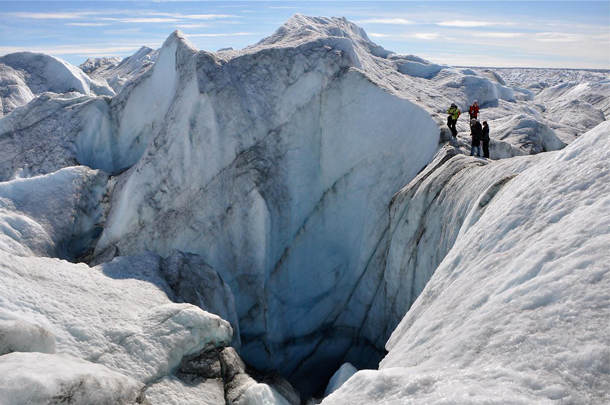
Towards the end of his Underland journey, Robert Macfarlane descended into a moulin, a chasm carved into glacial ice by meltwater. (Photo: Destination Arctic Circle, Flickr CC BY-NC-ND 2.0)
Links
Underland: A Deep Time Journey
Living on Earth wants to hear from you!
Living on Earth
62 Calef Highway, Suite 212
Lee, NH 03861
Telephone: 617-287-4121
E-mail: comments@loe.org
Newsletter [Click here]
Donate to Living on Earth!
Living on Earth is an independent media program and relies entirely on contributions from listeners and institutions supporting public service. Please donate now to preserve an independent environmental voice.
NewsletterLiving on Earth offers a weekly delivery of the show's rundown to your mailbox. Sign up for our newsletter today!
 Sailors For The Sea: Be the change you want to sea.
Sailors For The Sea: Be the change you want to sea.
 The Grantham Foundation for the Protection of the Environment: Committed to protecting and improving the health of the global environment.
The Grantham Foundation for the Protection of the Environment: Committed to protecting and improving the health of the global environment.
 Contribute to Living on Earth and receive, as our gift to you, an archival print of one of Mark Seth Lender's extraordinary wildlife photographs. Follow the link to see Mark's current collection of photographs.
Contribute to Living on Earth and receive, as our gift to you, an archival print of one of Mark Seth Lender's extraordinary wildlife photographs. Follow the link to see Mark's current collection of photographs.
 Buy a signed copy of Mark Seth Lender's book Smeagull the Seagull & support Living on Earth
Buy a signed copy of Mark Seth Lender's book Smeagull the Seagull & support Living on Earth

